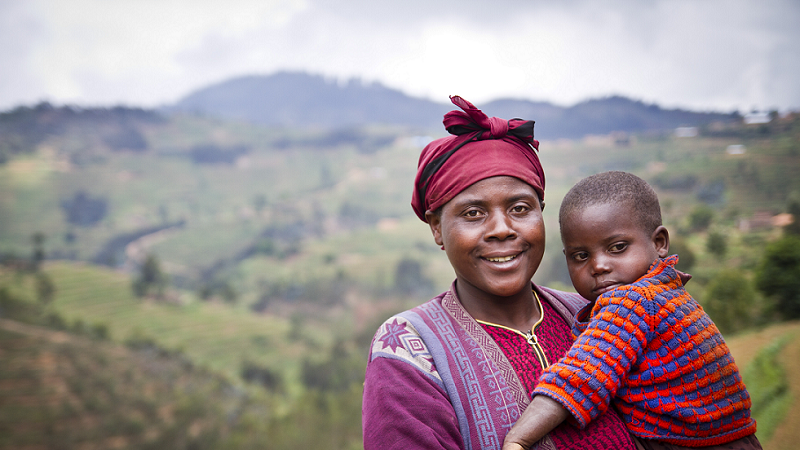In April 2010, a visionary group of donors and partners came together to launch the Global Agriculture and Food Security Program (GAFSP). Born out of the food crisis, with a view toward sustainable development, GAFSP works to finance medium- and long-term efforts to improve agricultural productivity, increase incomes, and ensure food and nutrition security in low-income countries. This month marks GAFSP’s fourth birthday and offers a milestone to reflect on the original goals of the program, its impact on the ground, and its place in the post-2015 agenda of ending poverty and building resilience.
At inception, partners had a clear vision. They wanted a program that could leverage limited donor resources to generate a large, sustainable impact on agriculture in the world’s poorest countries and improve the lives of smallholders through both public and private funding. Donors wanted this initiative to be country-led, to move quickly at a large scale, and to follow the principles of aid effectiveness including inclusive partnerships, donor harmonization, results focus, and capacity development.
Four years later, this vision is being realized. GAFSP is improving agricultural productivity, increasing incomes, and improving food security in 31 of the poorest or most malnourished countries across the globe with public and private sector development. By supporting country-designed programs, the portfolio includes a wide range of interventions responding specifically to individual countries’ needs. The impacts of projects on the ground are substantial.
In Rwanda, the project focuses heavily on poverty reduction. GAFSP funding is scaling up the government’s Land Husbandry, Water Harvesting, and Hillside Irrigation Project (LWH), which works to increase the productivity and commercialization of small farmers. After 2.5 years of implementation, the project has already reached more than 92,000 beneficiaries and yields of maize, beans, and Irish potato in treated areas are 30%, 167% and 219% above national averages, respectively. The project also looks at nutrition and gender by: improving access to nutrition-rich vegetables like iron-fortified beans, training communities in the construction and management of kitchen gardens, and partnering with local institutions to create innovative financial products for smallholder farmers, particularly women.
In Bangladesh, the GAFSP-financed Integrated Agriculture Productivity Project (IAPP) introduces better seed varieties, provides extensive training, and improves critical infrastructure for smallholder farmers. The IAPP marks the first time that all seven relevant government agencies have joined together in one project unit in order to provide the comprehensive services—including crop, livestock, fisheries, environment, and disaster relief—needed by project villages. IAPP prioritizes climate adaptive technologies and targets eight regions that are particularly vulnerable to the effects of climate change, including droughts, floods, and high salinity. After 2.5 years of implementation, this investment and capacity development program has reached 400,000 farmers, conducted 4,700 crop and fisheries demonstrations, and distributed 150 tons of certified seeds. According the World Bank analysis, 100% of the project activities have climate co-benefits.
With its current $1 billion portfolio, GAFSP is on track to reach more than 13 million people within the next five years, mostly smallholder farmers and their families. Most importantly, it helps countries develop the tools needed to avoid future crises and build resilience. But, the impact of the program is clear when you listen to the farmers.
“One of the GAFSP’s core goals is to efficiently pool and leverage donor fund to be able to provide support to countries that need it, when they need it, irrespective of budget or replenishment cycles,” says Geeta Sethi, Program Manager of GAFSP. “To sustain the momentum that program has created, additional donor funds are urgently needed.”
Once countries receive funds, GAFSP has served as a catalyst for additional financing and is a marker of credibility amongst donors. For example, after being allocated a $30 million GAFSP grant in September 2013, Honduras was able to leverage the funding with multiple donors to turn it into a $200 million project all of which will be streamlined through the same management systems.
“Smallholder farmers and others living in poverty in the world’s poorest countries remain particularly vulnerable to food price shocks and are likely to face increased competition over land, water, and other resources as a result of climate change,” wrote Treasury Secretary Jacob J. Lew and Secretary of State John F. Kerry in a recent letter to partner countries. “Together, we can make progress in the effort to eradicate hunger and poverty.”
To meet the goal of ending poverty in 2030, there must be a sustainable increase in the agricultural incomes of the poorest by 30 to 60%. As we look to the post-2015 aid agenda focused on ending poverty and building resilience, GAFSP is uniquely placed to help. In fact, it is one of the best mechanisms on the ground to scale up programs and achieve these objectives.
In October 2012, the United States challenged the international community to provide much needed funding for food security, by committing to contribute $1 to GAFSP for every $2 from other donors, up to a maximum U.S. contribution of $475 million. An additional $720 million in pledges from other donors is needed in order to fully leverage matching funds from the United States. The generosity of current donors in Australia, Canada, Ireland, Japan, Korea, the Netherlands, Spain, the United Kingdom, and the United States, plus the Bill and Melinda Gates Foundation, must be expanded and joined by others who want to help GAFSP develop to its full potential.

